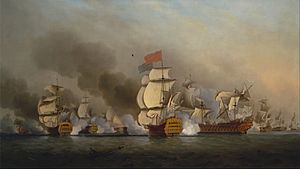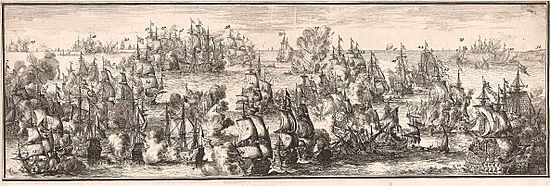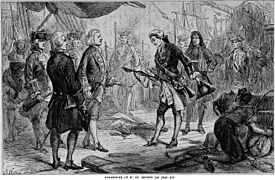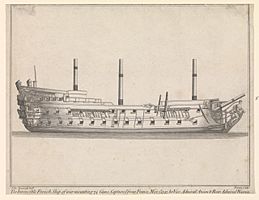First Battle of Cape Finisterre (1747) facts for kids
Quick facts for kids First Battle of Cape Finisterre |
|||||||
|---|---|---|---|---|---|---|---|
| Part of the War of the Austrian Succession | |||||||
 Lord Anson's victory off Cape Finisterre, Samuel Scott |
|||||||
|
|||||||
| Belligerents | |||||||
| Commanders and leaders | |||||||
| Strength | |||||||
| 14 ships of the line 1 frigate 1 sloop 1 fireship |
4 ships of the line 8 frigates 4 corvettes 30 merchant ships |
||||||
| Casualties and losses | |||||||
| 520 killed and wounded | 800 killed and wounded 3,000 captured 4 ships of the line captured 4 frigates captured 4 corvettes captured 6 merchantmen captured |
||||||
The First Battle of Cape Finisterre (14 May 1747) was waged during the War of the Austrian Succession. It refers to the attack by 14 British ships of the line under Admiral George Anson against a French 30-ship convoy commanded by Admiral de la Jonquière. The French were attempting to protect their merchant ships by using warships with them. The British captured 4 ships of the line, 2 frigates, and 7 merchantmen, in a five-hour battle in the Atlantic Ocean off Cape Finisterre in northwest Spain. One French frigate, one French East India Company warship, and the other merchantmen escaped.
Events
Prelude
France needed to keep shipping lanes open in order to maintain her overseas empire. To this end she assembled merchantmen into convoys protected by warships. Anson on Prince George and Rear-Admiral Sir Peter Warren on Devonshire had sailed from Plymouth on 9 April to intercept French shipping. When a large convoy was sighted, Anson made the signal to form line of battle. Rear-Admiral Warren, suspecting the enemy to be manoeuvring to promote the escape of the convoy, bore down and communicated his opinion to the admiral; the latter threw out a signal for a general chase.
Battle
Centurion under a press of sail, was the first to come up to the rearmost French ship, which she attacked severely, and two other ships dropped astern to her support. The action became general when three more British ships, including Devonshire, came up. The French, though much inferior in numbers, fought till seven in the evening, when all but two of their ships were taken, as well as nine East India merchantmen. The French lost 700 men killed and wounded, and the British 520. Over £300,000 was found on board the ships of war, which were turned into British ships.
François de Grasse, later the famous Comte, was wounded in this first battle. He was taken prisoner among the crew and officers on La Gloire, which was captured.
Aftermath
Following his victory, Anson was raised to the peerage. The French assembled another, much bigger, convoy which set sail in October. After Edward Hawke's defeat of this fleet in the Second Battle of Cape Finisterre, the French naval operations were ended for the rest of the war.
According to American historian William Williamson's 1832 account, the battle was a
"most severe blow to the French interests in America. Besides immense property taken, there were found on board … numerous articles designed for the Acadians and Indians".
Order of battle
Britain
| Vice-Admiral Anson's fleet | |||||||
|---|---|---|---|---|---|---|---|
| Ship | Guns | Commander | Notes | ||||
| Prince George | 90 | Vice-Admiral George Anson Captain John Bentley |
Not engaged | ||||
| Devonshire | 66 | Rear-Admiral Peter Warren Captain Temple West |
|||||
| Namur | 74 | Captain Hon. Edward Boscawen | |||||
| Monmouth | 64 | Captain Henry Harrison | Not engaged | ||||
| Prince Frederick | 64 | Captain Harry Norris | Not engaged | ||||
| Yarmouth | 64 | Captain Piercy Brett | |||||
| Princess Louisa | 60 | Captain Charles Watson | Not engaged | ||||
| Nottingham | 60 | Captain Philip de Saumarez | Not engaged | ||||
| Defiance | 60 | Captain Thomas Grenville † | |||||
| Pembroke | 60 | Captain Thomas Fincher | |||||
| Windsor | 60 | Captain Thomas Hanway | |||||
| Centurion | 50 | Captain Peter Denis | |||||
| Falkland | 50 | Captain Blumfield Barradall | Not engaged | ||||
| Bristol | 50 | Captain Hon. William Montagu | |||||
| Ambuscade | 40 | Captain John Montagu | Not engaged | ||||
| Falcon | 10 | Commander Richard Gwynn | Not engaged | ||||
| Vulcan | 8 | Commander William Pettigrew | Fireship, not engaged | ||||
France
| Chef d'escadre de la Jonquière's fleet | |||||||
|---|---|---|---|---|---|---|---|
| Ship | Guns | Commander | Notes | ||||
| Diamant | 30 | Captain Toussaint Hocquart | Captured | ||||
| Philibert | 30 | Captain Jacques Lars de Lescouet | French East India Company ship, captured | ||||
| Vigilant | 20 | Captain Pierre Bourau de Vauneulon | FEIC ship, captured | ||||
| Chiméne | 36 | Unknown captain | FEIC ship | ||||
| Rubis | 52 | Captain Macarty | En flute, captured | ||||
| Jason | 50 | Captain Beccart | Captured | ||||
| Sérieux | 64 | Chef d'escadre the Marquis de la Jonquière Captain Charles-Alexandre Morell d'Aubigny |
Captured | ||||
| Invincible | 74 | Captain Jacques-François Grout de Saint-Georges | Captured | ||||
| Apollon | 30 | Captain Noël | FEIC ship, captured | ||||
| Thétis | 22 | Captain Masson | FEIC ship, captured | ||||
| Modeste | 18 | Captain Thiercelin | FEIC ship, captured | ||||
| Gloire | 40 | Captain de Saliez † | Captured | ||||
| Emeraude | 40 | Captain Clément de Taffanel de La Jonquière | Not in line of battle | ||||
| Dartmouth | 18 | Unknown captain | Not in line of battle, captured | ||||
See also




